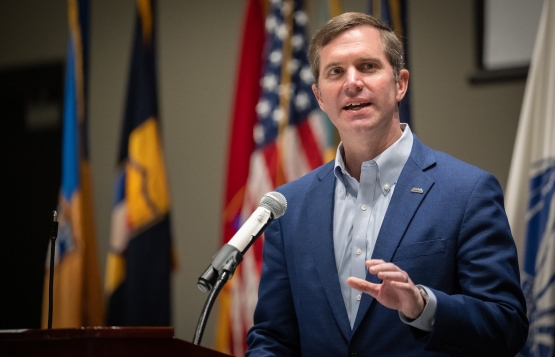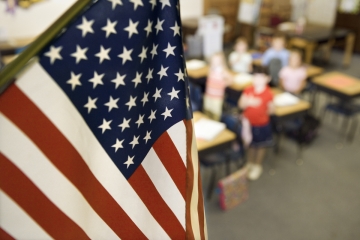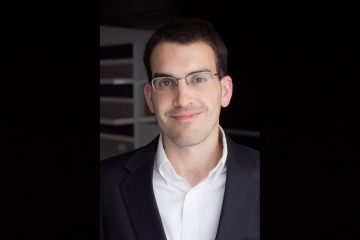Editor’s note: This was first published by The Liberty Fund.
The state of civic education in America is low but the stakes are high. Benjamin Franklin warned about the dangers when he was asked what kind of government the Founders had given us: “A Republic, if you can keep it,” Franklin responded. It turns out that nothing is more foundational to keeping the republic than robust civic education. The whole of the republic—its constitutional order and its protection of “life, liberty and the pursuit of happiness”—relies on a virtuous and educated people. Sadly, all of that has been in a steep decline and is now at risk.
Liberty and republicanism require civic education
The Founders understood that to enjoy the fruits of liberty, the American people would need to be virtuous, including a civic virtue that required them to look out not just for themselves but to sacrifice for the good of the whole. Recognizing that “enlightened statesmen would not always be at the helm,” as James Madison put it in Federalist No. 10, the Founders also built into the Constitution an elaborate balancing of interests and powers, including checks and balances and separations of power of many kinds. As scholar Gordon Wood observed, the Founders married religious virtue with modern political science in order to keep and sustain the republic.
For both pillars of the republic—civic virtue and constitutional order—a robust civic education would be required. As the Massachusetts Constitution of 1780 put it: “The most obvious republican instrument for…inculcating virtue in a people was education…being necessary for the preservation of rights and liberties.” Nearly all the leading Founders pledged allegiance to robust and widespread education in order to keep the republic. In his final message to Congress, President George Washington urged the expansion of education as essential to the perpetuation of the new nation’s common values and the chance of a “permanent union.” Thomas Jefferson argued that education made possible the very consent of the people on which the government was built. Indeed, Jefferson advocated public education from the earliest grades through the university. John Adams asserted that education of all classes of people should be a concern of the government and funded at public expense.
As Notre Dame scholar David Campbell has pointed out, the primary purpose of public schooling in the founding era was civic education. “U.S. public schools were actually created for the express purpose of creating democratic citizens,” Campbell has written. Legendary educator John Dewey warned in his 1916 book Democracy in Education that even teaching the “three R’s” (reading, writing and ‘rithmetic) were not enough to achieve the goal to “educate a useful citizen.” American schools were founded not to train students for jobs but to prepare them to be citizens of their democratic republic. My, how things have changed.
The sad state of civic education today
The Founders would be sorely disappointed to see the low priority schools now give to civic education. It is hardly taught at all in elementary and middle schools, reduced now in most states to a single course in high school. The most recent NAEP (National Assessment of Educational Progress (also called “the Nation’s Report Card”) scores show that only 22 percent of American 8th graders are “proficient” or better in US government and civics, while a shocking 13 percent are proficient or better in US history. Unfortunately, this problem is not limited to 8th graders. A study by the Woodrow Wilson National Scholarship Foundation found that only one in three Americans could pass the civics portion of the citizenship test, which immigrants pass at more than a 90 percent rate. Other surveys show that Americans don’t know the three branches of government and can’t name a single right guaranteed by the First Amendment. Some think Judy Judge is on the Supreme Court and that climate change was triggered by the “Cold” war.
In an October, 2020 study for the Orrin G. Hatch Foundation, I described the primary causes of the decline in civic education. A series of education crises has prompted huge turns away from the teaching of civics—as well as the humanities and social sciences more broadly—to other topics deemed more urgent to the national interest. The Soviet firing of the first space satellite, Sputnik, in 1957 not only led to an acceleration of America’s space program but also to a greater emphasis on science in our schools. Similarly, a major national report, “A Nation At Risk” in 1983, sounded an alarm that American students were falling behind their international peers and led to increased curricular demands for reading and math in schools. The federal “No Child Left Behind” law in 2001 codified this emphasis and required extensive student testing, especially in reading and math. Since neither the school day nor school year were lengthened to make room for these curricular additions, they came at the expense of social science and the humanities, including civic education. Now there was essentially no teaching of civics in elementary and middle schools, with only a single one-semester course in high school—too little too late.
And this shift away from civics is hardly over. The new rage is STEM (science, technology, engineering and math) education so that students will be qualified for jobs in those fields. One widely quoted estimate is that the federal government now spends $54 per child per year on STEM education and only five cents on civics! National testing on civics and history are given only once, in the 8th grade, whereas more “important” subjects are tested in the 4th and 12th grades as well. The clear message we are giving is that civic education is no longer of real importance.
Too Little civic education puts liberty and the republic at risk
We are already seeing downstream effects of poor civic education. Americans’ trust in government has been in steady decline, with young people leading the way. The Pew Research Center has studied trust in government since 1958 and finds it at “near historic lows” at only 24 percent. This lack of trust is especially prevalent among young people, as older Americans expressed trust at nearly double the rate of the young. Of course, the obvious cause is a lack of understanding: how can you trust what you do not understand? As one study noted, “Those who are bewildered by such basics as the branches of government and the concept of judicial review are less likely to trust the court…Importantly, those who have taken a high school civics class are more likely to command key constitutional concepts.” Clearly poor civic education has put trust at risk.
Another downstream effect of poor civic education is low voter turnout and reduced civic participation. Alia Wong pointed out in The Atlantic that only half of eligible adults ages 18-29 voted in the 2016 presidential election, and only 20 percent in the 2014 midterm election. Among older age groups, two-thirds voted in 2016. Experts agree that, again, poor civic education is a root cause, and there is widespread agreement that better civic education would help. Poor civic education has put voting and civic participation at risk.
The risk to liberty from poor civic education is shown even more clearly by how poorly young people understand socialism, communism, and the free market systems. Previously thought of as anathema to most Americans, socialism has now become popular, even trendy, among younger generations. A number of polls and surveys and recent years attest to this rising acceptance of socialism among the young. As early as 2014, a Reason-Rupe study showed that 58 percent of young people ages 18-24 held a favorable view of socialism. A 2016 YouGov survey showed that 43 percent of young people held a favorable view of socialism; similarly a 2018 Gallup Poll number was at 51 percent. Even more alarming, a 2019 Harris Poll found that 49.6 percent of Millennials and Gen Zers would prefer to live in a socialist country, while a 2021 YouGov poll said 36 percent of those groups had a favorable view of communism.
The favorability of socialism is generational but it is also educational. Apparently when young people use the term socialism, they are not thinking of its classic definition: an economic system in which the people own the means of production and distribution. The Gallup organization published a poll on the meaning of socialism in October, 2018, and found the following top three understandings of the term: equality (23 percent), government ownership and control of business (21 percent) and free services from the government (10 percent). For every respondent who understood the classic definition of socialism, two thought it meant equality and free goods. In a 2010 New York Times/CBS poll, only 16 percent of young people could accurately define socialism.
Digging a little deeper, one finds a direct contradiction between young people’s favorable view of socialism and their preference for who should run business. In the same 2014 Reason-Rupe survey where 58 percent of young people held a favorable view of socialism, they preferred markets over government to lead the economy by a two-to-one margin. Likewise, the May 2019 Gallup Poll found 43 percent saying socialism would be good for the country, yet they chose market control over government control of everything from the economy to wealth distribution and even healthcare. Clearly there is a major educational gap in young people’s understanding of the American market system compared with socialism.
American politicians have exacerbated the misunderstanding of socialism. When Senator Bernie Sanders and others identified Denmark as a kind of socialist, or democratic socialist, economy in the 2016 presidential campaign, the Danish Prime Minister felt the need to clarify that Denmark was not socialist but rather “a market economy” with “an expanded welfare state.” It turns out that when young people say they like socialism, what they really want is an expanded welfare state and more free stuff from the government. This basic lack of understanding of economic systems shows a major deficit in their education, one that a more robust civic education should address.
Grave dangers face liberty and the republic including loss of trust in government, low voter turnout and civic participation, and misunderstanding of how the American system actually works. Surely this is a crisis of even greater proportion and consequence than Sputnik or international test scores or preparing for jobs in the new economy. As Chief Justice John Roberts has said, we have let civics fall by the wayside and we need to revive it in order to protect our democracy.
Revisionist and politicized content of history and civics endangers liberty
Beyond the problem of too little civic education is the politicized content of much of history and civics today. Howard Zinn’s A People’s History of the United States in 1980 launched a major turn away from a more positive view of US history and civics that had been the consensus toward a series of political attacks on American history and a new revisionist history. Originally thought of as a kind of supplemental American history text, Stanford University education professor Sam Wineburg has said that Zinn’s text “has arguably had a greater influence on how Americans understand their past than any other book.”
Zinn starts right in with Christopher Columbus who, according to Zinn, was not an explorer and discoverer but rather a greedy murderer pursuing the gold of native Indians. The founding of America, per Zinn, was a myth invented by the upper class and sold to the common man, with the Constitution really aimed at preserving the wealth of a few over the many who were poor. As Gordon Lloyd, an expert on the American founding, has said: “It’s hard to love an ugly founding,” which is exactly what Zinn has offered to students.
Now the 1619 Project, introduced by the New York Times in 2019, has continued the negative and revisionist history of the US. It seeks to reframe the founding of the country as the time when slaves first came to the continent, rather than the traditional founding dates of 1776 with the Declaration and the American Revolution, and 1787 with the signing of the Constitution. The Project would establish the economic and social institution of slavery as the real founding story, not the principles of liberty and equality proclaimed by the Declaration and the unique political system established by the Constitution. The Pulitzer Center has undertaken to bring the 1619 Project into the classroom for widespread adoption and use. Other education movements such as critical race theory, action civics and ethnic studies have accelerated a leftward and negative revision of US history and civics.
If American history is all about money and greed, little room is left for an appreciation of liberty and the political order. Instead of creating patriots with a love of country, we are often teaching ideas that cause students to hate America. As Thomas Jefferson said, “Everything depends on establishing this love in a republic. And to inspire it ought to be the principal business of education.” Turning this misguided approach to history and civics around will be a big undertaking, indeed.
Some good news
Fortunately, it is possible to improve civic education without waiting for a sweeping bill from a divided Congress or a major investment from a billionaire philanthropist. A number of important contributions can and should be made by parents, citizens, educators and political leaders that could secure the future of liberty and the republic. But the time to start is now, before the decline becomes irreversible.
In his farewell address, President Ronald Reagan chose to emphasize the need for better civic education, stating clearly where it must begin. Reagan went right to the need to protect liberty, saying, “We’ve got to do a better job of getting across that America is freedom,” adding that freedom is “fragile” and “needs protection.” So, he continued, we have to do a better job of teaching history, pointing out that losing our national memory would “result, ultimately, in an erosion of the American spirit.” We must “start with some basics,” Reagan said, with “more attention to American history and a greater emphasis on civic ritual.”
But then he turned to the question of where to begin, and it was not with politicians or even schools. Instead, Reagan offered, “all great change in America begins at the dinner table.” Parents must take the lead in teaching “what it means to be an American.” Reagan stated a goal, which was valuable in itself: Developing “an informed patriotism.”
Then schools must do their part and this starts with state legislatures and boards of education requiring more civics to be taught. The gold standard should be some teaching of civics in age-appropriate ways every year beginning in kindergarten. Then students are ready for a full year—not just a semester as is common now—of civics in high school. The federal government, which oversees the NAEP test, should require it be given in government and history in grades 4 and 12 as well as 8. All of this carries the clear message that civics are important.
How we prepare teachers of civics is also important. The best practice is to teach US history and civics using primary documents: the Constitution and Declaration, certainly, but also speeches and essays of the period. Students need to leave their 21st century lenses behind and travel back to key moments in American history to understand why our republic works as it does, and how it could be maintained and strengthened. This is both less boring than textbooks and less politically controversial, allowing students to study history and civics on their own terms and draw their own conclusions.
We have a long way to go to strengthen our grip on liberty and the future of the republic with better civic education. This is at least as big an educational crisis as Sputnik or STEM, and we will need all hands on deck to promote better civic education.








